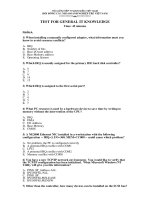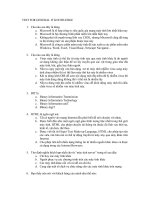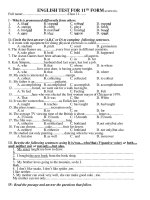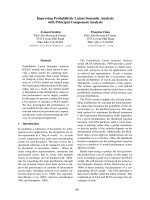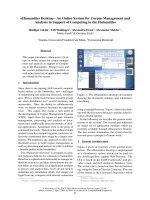An Eigenvalue test for spatial principal component analysis
Bạn đang xem bản rút gọn của tài liệu. Xem và tải ngay bản đầy đủ của tài liệu tại đây (987.44 KB, 7 trang )
Montano and Jombart BMC Bioinformatics (2017) 18:562
DOI 10.1186/s12859-017-1988-y
METHODOLOGY ARTICLE
Open Access
An Eigenvalue test for spatial principal
component analysis
V. Montano1*
and T. Jombart2
Abstract
Background: The spatial Principal Component Analysis (sPCA, Jombart (Heredity 101:92-103, 2008) is designed to
investigate non-random spatial distributions of genetic variation. Unfortunately, the associated tests used for assessing
the existence of spatial patterns (global and local test; (Heredity 101:92-103, 2008) lack statistical power and may fail to
reveal existing spatial patterns. Here, we present a non-parametric test for the significance of specific patterns
recovered by sPCA.
Results: We compared the performance of this new test to the original global and local tests using datasets simulated
under classical population genetic models. Results show that our test outperforms the original global and local tests,
exhibiting improved statistical power while retaining similar, and reliable type I errors. Moreover, by allowing to test
various sets of axes, it can be used to guide the selection of retained sPCA components.
Conclusions: As such, our test represents a valuable complement to the original analysis, and should prove useful for
the investigation of spatial genetic patterns.
Keywords: Eigenvalues, sPCA, Spatial genetic patterns, Monte-Carlo
Background
The principal component analysis (PCA; [1, 2]) is one of
the most common multivariate approaches in population
genetics [3]. Although PCA is not explicitly accounting
for spatial information, it has often been used for investigating spatial genetic patterns [4]. As a complement to
PCA, the spatial principal component analysis [5] has
been introduced to explicitly include spatial information
in the analysis of genetic variation, and gain more power
for investigating spatial genetic structures.
sPCA finds synthetic variables, the principal components (PCs), which maximise both the genetic variance
and the spatial autocorrelation as measured by Moran’s I
[6]. As such, PCs can reveal two types of patterns: ‘global’
structures, which correspond to positive autocorrelation
typically observed in the presence of patches or clines,
and ‘local’ structures, which correspond to negative autocorrelation, whereby neighboring individuals are more
genetically distinct than expected at random (for a more
detailed explanation on the meaning of global and local
structures see [5]). The global and local tests have been
developed for detecting the presence of global and local
patterns, respectively [5]. Unfortunately, while these tests
have robust type I error, they also typically lack power, and
can therefore fail to identify existing spatial genetic
patterns [5]. Moreover, they can only be used to diagnose
the presence or absence of spatial patterns, and are unable
to test the significance of specific structures revealed by
sPCA axes.
In this paper, we introduce an alternative statistical test
which addresses these issues. This approach relies on
computing the cumulative sum of a defined set of sPCA
eigenvalues as a test statistic, and uses a Monte-Carlo procedure to generate null distributions of the test statistics
and approximate p-values. After describing our approach,
we compare its performances to the global and local tests
using simulated datasets, investigating several standard
spatial population genetics models. Our approach is
implemented as the function spca_randtest in the package
adegenet [7, 8] for the R software [9].
* Correspondence:
1
School of Biology, University of St Andrews, Bute Building, St Andrews KY16
9TS, UK
Full list of author information is available at the end of the article
© The Author(s). 2017 Open Access This article is distributed under the terms of the Creative Commons Attribution 4.0
International License ( which permits unrestricted use, distribution, and
reproduction in any medium, provided you give appropriate credit to the original author(s) and the source, provide a link to
the Creative Commons license, and indicate if changes were made. The Creative Commons Public Domain Dedication waiver
( applies to the data made available in this article, unless otherwise stated.
Montano and Jombart BMC Bioinformatics (2017) 18:562
Methods
Test statistic
As in most multivariate analyses of genetic markers, our
approach analyses a table of centred allele frequencies (i.e.
set to a mean frequency of zero), in which rows represent
individuals or populations, and columns correspond to
alleles of various loci [3, 5, 10]. We note X the resulting
matrix, and n the number of individuals analysed. In
addition, the sPCA introduces spatial data in the form of a
n by n matrix of spatial weights L, in which the ith row
contains weights reflecting the spatial proximity of all
individuals to individual i. The PCs of sPCA are then
found by the eigen-analysis of the symmetric matrix
(Jombart et al. [5]):
À
Á
1=ð2nÞX T LT þ L X
We note λ the corresponding non-zero eigenvalues. We
differentiate the r positive eigenvalues λ+, corresponding
to global structures, and the ‘s’ negative eigenvalues λ−,
corresponding to local structures, so that λ = {λ+,λ−}.
Without loss of generality, we assume both sets of eigenvalues are ordered by decreasing absolute value, so that
λ+1 > λ+2 > … > λ+r and |λ−1 | > |λ−2 | > … > |λ−s |. Simply put,
each eigenvalue quantifies the magnitude of the spatial
genetic patterns in the corresponding PC: larger absolute
values indicate stronger global (respectively local)
Page 2 of 7
structures. We note V+ = {v+1 , …, v+r } and V− = {v−1 , …, v−s }
the sets of corresponding PCs.The most natural choice of
test statistic to assess whether a given PC contains significant structure would seem to be the corresponding eigenvalue. This would, however, not account for the
dependence on previous PCs: v+j (respectively v−j ) can only
be significant if all previous PCs {v+1 , …, v+j-1} are also significant. To account for this, we define the test statistic for
v+j as:
f i þ ¼ Σi¼1;…;j λi þ
and as:
f i − ¼ Σi¼1;…;j j λi − j
for v−j .
f+i and f−i become larger in the presence of strong
global or local structures in the first ith global/local PCs.
Therefore, they can be used as test statistics against the
null hypotheses of absence of global or local structures in
these PCs. The expected distribution of f+i and f−i in the
absence of spatial structure is not known analytically.
Fortunately, it can be approximated using a Monte-Carlo
procedure, in which at each permutation individual genotypes are shuffled to be assigned to a different pair of
coordinates than in the observed original dataset and f+i
and f−i are computed. Note that the original values of the
Fig. 1 Flow chart illustrating the steps of the spca_randtest. The first step on the top panel shows one permutation that is used to obtain one
value of fi + and fi-. To assess the statistical significance of global either local patterns permutations are repeated x times to obtain empirical
distributions of fi + and fi- that are thus compared to the observed values of fi + and fi-. If at least one of the two is significant, the second step of
the test exploits the eigenvalue distribution recorded over the permutations to obtain an empirical p-value for each eigenvalue, starting from the
most positive (or most negative). As the first eigenvalue is significant in comparison with a chosen threshold, the following is tested and
compared to a more stringent threshold (Bonferroni correction) until a non-significant eigenvalue is found and the routine stops
Montano and Jombart BMC Bioinformatics (2017) 18:562
test statistic are also included in these distributions, as the
initial spatial configuration is by definition a possible
random outcome. The p-values are then computed as the
relative frequencies of permuted statistics equal to or
greater than the initial value of f+i or f−i .
To guide the selection of global and local PCs to
retain, the simulated values of each eigenvalue (from
most positive to most negative), which make up the f+i
and f−i statistics, are also recorded during the permutation procedure. In this way, if global or local structures
are detected to be significant, an observed p-value for
each observed eigenvalue can be estimated by comparison with its simulated eigenvalue distribution. Note that
the number of eigenvalues produced by an sPCA does
not change between the observed and permuted datasets, so each observed eigenvalue can be compared with
the distribution of the corresponding simulated one.
This testing procedure can be used with increasing numbers of retained axes, testing the significance of a new axis
as long as previous axes showed significant structure. As
one test is performed per axis, we use Bonferroni correction to avoid the inflation of type I error, so that the
significance level for the ith PC will be α/i, where α is the
target type I error. Hence, the correction implies that if
the most positive (or negative) eigenvalue is significant in
regards with the chosen p-value threshold, the second
Page 3 of 7
eigenvalue is tested for a p-value threshold that is the half
of the previous and so on. The entire testing procedure is
implemented in the function spca_randtest in the package
adegenet [7, 8] for R [9]. A flow chart of the test procedure
is shown in Fig. 1.
Simulation study
To assess the performance of our test, we simulated genetic data under three migration models: island (IS) and
stepping stone (SS), using the software GenomePop 2.7
[11], and isolation by distance (IBD), using IBDSimV2.0
[12]. We simulated the IS and SS models with 4 populations, each with 25 individuals, and a single population
under IBD with 100 individuals. 200 unlinked biallelic
diploid loci (or single nucleotide polymorphisms; SNPs)
were simulated. Populations evolved under constant effective population size θ = 20, and interchanged migrants
at three different symmetric and homogeneous rates
(0.005, 0.01, and 0.1). We performed 100 independent
runs for each of the three migration rates, for a total of
300 simulated dataset per migration model. An example
of input file for GenomePop 2.7 and IBDSimV2.0 are
included as Additional files 1 and 2.
To quantify type I error rates for the spca_randtest,
global and local tests, we extracted 100 random coordinates from 10 square 2D grids, using the function
Fig. 2 Graphical representation of island and stepping stone migration models (IS and SS) in the panel above. Black rows represent the presence and
direction of migration rates among populations (purple circles). The panel below represents two examples of simulated global patterns, where a set of 100
pairs of coordinates are picked from a set of 1000 random pairs of coordinates built in 2D squares at different scales (in the example here reported the scales
are 1:10,000 and 1:100,000, respectively). Every 25 pairs of coordinates are assigned to a different simulated population, distinguished by red, blue, black and
yellow colors, in order to obtain spatially segregated populations. These simulated spatial distributions are used to calculate the matrix L of spatial connection
(see Additional file 3: Figure S1)
Montano and Jombart BMC Bioinformatics (2017) 18:562
Page 4 of 7
spsample from the spdep package [13]. In order to evaluate the rate of false negatives for global patterns, we
manually generated 10 sets of 100 pairs of coordinates
simulating gradients and/or patches from 2D grids. An
example of simulated global patterns is presented in
Fig. 2. To test for the rate of false negatives for local
patterns, we perform a principal component analysis on 10
random datasets simulated under the SS model with 0.005
migration rate. We used the coordinates of the individuals
on the first principal component and set the second coordinate to zero for all individuals (1D). With the coordinates
so produced, we used the function chooseCN in adegenet to
obtain 10 neighbouring graphs where the most genetically
distinct individuals (falling in the upper quartile of the pairwise genetic distances) are considered as neighbors, while
the others are non-neighbors.
We tested 100 simulations each for all the 30 sets
of geographic coordinates (random, positive and negative), for each of the three migration rates (0.005,
0.01 and 0.1), for each of the three migration models
(IS, SS, IBD; total of 9000 tests per migration model).
We repeated all tests using a subset of 40 SNPs per
individual, for a total of 18,000 tests in the absence
of spatial structures, and and 36,000 tests in the presence of global or local structures.
Results
Statistical power of the spca_randtest
We compared the performances of the spca_randtest with
the global and local tests in three settings: in the absence of
spatial structure, and in the presence of global, and local
structures. The results obtained in the absence of spatial
structure show that all tests have reliable type I errors
(Table 1 and 2). The spca_randtest exhibited consistently
better performances for detecting existing structures in the
data than both global and local tests (Table 1 and 2). Although our simulated local spatial patterns turned out more
difficult to detect than global patterns, the spca_randtest is
twice to five times more effective than the local test (Table
1 and 2). Generally, the underlying migration model, the
migration rate and the number of loci affect the ability of
all tests to detect non-random spatial patterns. Both spca_randtest and global and local tests have in fact a lower sensitivity in presence of island migratory schemes, while results
for stepping stone and isolation by distance models are
more satisfying (Table 1 and 2). Increasing migration rates
lead to a higher rates of false negatives for all tests, which
can be overcome using more loci (Table 1 and 2).
Significant eigenvalues are assessed using a hierarchical
Bonferroni correction which accounts for non-independence
of eigenvalues and multiple testing (Fig. 2). Strong patterns
Table 1 Significant results for global test (g test), local tests (l test), and spca_randtest (r test +/−) for random, global and local
patterns using 200 loci per individual. IS, SS, IBD indicate the migration models (see Methods); different migration rates are coded by
number: 1 = 0.005, 2 = 0.01 and 3 = 0.1
200 SNPs
Random Patterns
Global Patterns
Local Patterns
Models
Significance level
g test
r test (+)
l test
r test (−)
g test
r test (+)
l test
rt est. (−)
g test
r test (+)
l test
r test (−)
IS-1
.05
0.054
0.059
0.041
0.047
0.947
0.985
0.029
0.001
0.047
0.071
0.061
0.284
.01
0.011
0.007
0.009
0.010
0.822
0.948
0.005
0.001
0.008
0.010
0.015
0.113
IS-2
.05
0.040
0.041
0.058
0.056
0.227
0.564
0.044
0.018
0.056
0.059
0.050
0.123
.01
0.007
0.009
0.009
0.013
0.067
0.302
0.005
0.002
0.011
0.007
0.012
0.026
IS-3
.05
0.051
0.040
0.053
0.041
0.055
0.049
0.045
0.047
0.049
0.047
0.044
0.059
.01
0.010
0.014
0.013
0.008
0.010
0.013
0.007
0.013
0.002
0.014
0.008
0.019
SS-1
.05
0.053
0.058
0.053
0.050
0.986
0.996
0.022
0.000
0.063
0.064
0.124
0.582
.01
0.007
0.011
0.010
0.010
0.960
0.988
0.002
0.000
0.017
0.010
0.041
0.398
SS-2
.05
0.044
0.058
0.058
0.063
0.798
0.909
0.047
0.004
0.034
0.044
0.059
0.316
.01
0.011
0.011
0.013
0.016
0.676
0.771
0.010
0.000
0.004
0.005
0.014
0.147
SS-3
.05
0.047
0.046
0.057
0.049
0.054
0.128
0.040
0.042
0.044
0.054
0.049
0.071
.01
0.014
0.007
0.011
0.013
0.014
0.036
0.006
0.010
0.003
0.009
0.006
0.009
.05
0.044
0.050
0.053
0.048
0.962
0.999
0.021
0.000
0.025
0.087
0.438
0.809
IBD-1
.01
0.008
0.012
0.009
0.010
0.926
0.997
0.003
0.000
0.009
0.023
0.192
0.694
IBD-2
.05
0.052
0.045
0.061
0.038
0.967
0.998
0.023
0.000
0.046
0.076
0.451
0.794
.01
0.009
0.008
0.011
0.009
0.932
0.997
0.004
0.000
0.009
0.018
0.208
0.672
IBD-3
.05
0.052
0.046
0.053
0.050
0.977
0.999
0.015
0.000
0.050
0.083
0.441
0.824
.01
0.013
0.009
0.011
0.012
0.939
0.999
0.005
0.000
0.009
0.023
0.225
0.684
*p-values are in italic when non significant and in bold when the fraction of true positive is above 20%
Results show the proportion of significant tests over 1000 replicates, based on 1000 permutations with thresholds .05 and .01
Montano and Jombart BMC Bioinformatics (2017) 18:562
Page 5 of 7
Table 2 Results for the same simulations reported in Table 1 using a subset of 40 loci per individual
40 SNPs
Random Patterns
Global Patterns
Local Patterns
Models
Significance level
g test
r test (+)
l test
r test (−)
g test
r test (+)
l test
r test (−)
g test
r test (+)
l test
r test (−)
IS-1
.05
0.052
0.061
0.046
0.050
0.591
0.807
0.033
0.004
0.036
0.000
0.055
0.077
.01
0.016
0.013
0.010
0.007
0.393
0.592
0.005
0.000
0.004
0.000
0.015
0.022
.05
0.053
0.047
0.038
0.042
0.103
0.226
0.046
0.020
0.073
0.000
0.057
0.038
.01
0.011
0.009
0.006
0.006
0.022
0.072
0.011
0.005
0.012
0.000
0.010
0.006
.05
0.047
0.050
0.050
0.045
0.048
0.060
0.044
0.042
0.036
0.000
0.053
0.026
.01
0.009
0.011
0.008
0.007
0.009
0.011
0.011
0.011
0.002
0.000
0.013
0.001
.05
0.052
0.054
0.039
0.049
0.898
0.949
0.017
0.000
0.050
0.001
0.067
0.169
.01
0.009
0.012
0.005
0.011
0.826
0.865
0.006
0.000
0.007
0.000
0.021
0.052
.05
0.046
0.045
0.050
0.046
0.528
0.588
0.044
0.009
0.052
0.000
0.048
0.081
.01
0.013
0.010
0.010
0.015
0.377
0.370
0.016
0.000
0.005
0.000
0.011
0.014
.05
0.068
0.040
0.050
0.048
0.066
0.055
0.053
0.033
0.026
0.000
0.047
0.023
IS-2
IS-3
SS-1
SS-2
SS-3
.01
0.014
0.005
0.013
0.012
0.012
0.009
0.005
0.006
0.006
0.000
0.008
0.000
IBD-1
.05
0.049
0.053
0.052
0.057
0.822
0.883
0.027
0.002
0.034
0.055
0.124
0.480
.01
0.005
0.008
0.013
0.013
0.755
0.742
0.004
0.000
0.005
0.008
0.032
0.278
IBD-2
.05
0.043
0.054
0.060
0.049
0.835
0.880
0.028
0.001
0.043
0.051
0.111
0.458
.01
0.011
0.007
0.015
0.009
0.755
0.732
0.005
0.000
0.008
0.015
0.026
0.259
.05
0.043
0.042
0.051
0.050
0.844
0.899
0.026
0.002
0.048
0.058
0.115
0.465
.01
0.012
0.013
0.012
0.010
0.763
0.756
0.007
0.000
0.009
0.010
0.023
0.263
IBD-3
*p-values are in italic when non significant and in bold when the fraction of true positive is above 20%
(e.g. IBD) tend to produce a higher number of significant
components than weak patterns (e.g. island models with
high migration rates), which are otherwise captured by fewer
to no components.
Application to real data
We have run the sPCA to compare the new spca_randtest
and previous tests to a real dataset of human mitochondrial
DNA (mtDNA). We used a dataset of 85 populations from
Central-Western Africa that spans a big portion of the
African continent (from Gabon to Senegal; [14]). Previous
analysis on these data detected a clear genetic structure
from West to Central Africa with ongoing stepping stone
migration movements. We therefore expected that this
spatial distribution of genetic variation would be detected
as significant. In the sPCA, populations were treated as
units of the analysis, for which allele frequencies of mtDNA
polymorphisms are calculated per population. The same
approach was used in [14] to run a discriminant analysis of
principal components (DAPC; [10]) and detect population
genetic structure. The sPCA analysis is found non significant by global and local tests after 10,000 permutations
(p-value >0.5), while the spca_randtest detects a significant global pattern already with 500 permutations, and
with 10,000 permutations the p-value for global patterns
is 0.005. The second step of the test on single eigenvalues
finds the three most positive components to be significant
after Bonferroni correction (Table 3). Significant axes can
thus be plotted against the spatial network to give a
biological interpretation to the results (Fig. 3).
Discussion
We introduced a new statistical test associated to the
sPCA to evaluate the statistical significance of global and
Table 3 Results of the spca_randtest with 10,000 permutations on the human mtDNA dataset (Montano et al., [14])
Spatial patterns
Observed p-value
Global pattern
0.0058
Local pattern
0.8826
Decreasing Positive Eigenvalues
Observed p-value
Bonferroni corrected significant level
3.4e-2
0.0105
0.05
8.5e-3
0.0137
0.025
4.1e3
0.0136
0.016
1.6e-3
0.506
0.0125
The simulated distribution of the f+i and f−i statistics are compared to the f+i and f−i statistics observed for the original dataset. A significant global pattern (or
significant f+i observed statistics) is found with the spca_randtest (p-value <0.01). Thus, each positive eigenvalue is compared with its simulated distribution and
assigned to be significant if its observed p-value is lower than the corrected Bonferroni p-value, with starting threshold of 0.05. Significant observed p-values as
compared with Bonferroni corrected p-values are highlighted in bold
Montano and Jombart BMC Bioinformatics (2017) 18:562
Page 6 of 7
Fig. 3 Plot of the first and second most positive observed eigenvalues of the mtDNA dataset here analysed. The background map represents the
countries from where the populations included into the original study were sampled (from West to East: Senegal, Guinea-Bissau, Guinea, Sierra Leone,
Liberia, Ivory Coast, Ghana, Togo, Benin, Nigeria, Cameroon, Equatorial Guinea, Gabon, Congo). sPC1 and sPC2 are represented independently using a
square size proportional to the value of each population along the first and second component, respectively. Whites squares show negative values
and black squares the positive values, with size being proportional to the absolute value of the coordinate. sPC1-sPC2 is a summarized representation
of the values along the first and second component assumed by each population, using a color gradient. The maps were produced using rworldmap
R package [15]. Genetic data and geographical coordinates of the populations analysed are publicly available from Montano et al. ([14])
local spatial patterns. Using simulated data, we show that
this new approach outperforms previously implemented
tests, having greater statistical power (lower type II errors)
whilst retaining consistent type I errors. Our simulations
also suggest that demographic settings and migratory
models can substantially impact the ability to detect spatial
patterns. Indeed, high migration rates, non-hierarchical migration models, such as island model, and low amount of
loci can hamper or worsen the performance of the test, preventing the detection of actual spatial patterns. In lack of
previous information on the demographic history and/or
the movement ecology of the population under study, it is
certainly useful to exploit all the available genetic information. In this regards, our simulations show how an increased
number of loci does improve the ability of the test to
provide meaningful results.
The impact of specific factors such as the effective population size or the number of individuals sampled per population remain to be investigated. A more extensive simulation
study, possibly comparing different non-model based
methods such as sPCA, would clarify the extent of the
spatial information that can be obtained with such methods
without comparing explicit evolutionary hypotheses. In fact,
the sPCA and the associated spca_randtest cannot distinguish between explicit migration models. However, the
possibility to detect which eigenvalues contain the spatial
information provides the user with further information to
interpret the biological meaning of the spatial structure, by
focusing on few meaningful dimensions.
Our data application seems to confirm that the
spca_randtest is more effective than global or local
tests. We chose indeed a previously published dataset
of human populations which span a subcontinental area
of Africa and had been originally detected to be a highly
structured dataset with a geographic cline of population
differentiation (Montano et al. [14]). On the basis of the
original results, we would have expected a spatial global
structure to be present in the data and thus detected with
an sPCA. While the global test failed to provide statistical
significance, the spca_randtest did obtain significant
results and pointed to the three first most positive components to be also significant after Bonferroni correction. In
agreement with the original interpretation of the genetic
structure within the samples, spatial component 1 (SP1)
shows a clear differentiation of populations in the GabonCongo region, while SP2 detects differentiation of Central
Nigerian and North Cameroonian populations, on one
hand, and extreme Western populations of Senegal, on
the other hand (Fig. 3). The colored combination of the
first and second most positive component (Fig. 3) also
correctly detects a more fragmented differentiation across
Central forested areas (Cameroon, Gabon and Congo)
compared to more homogeneous Central-Western populations, which was the main result of the original publication based on very different approaches [14]. We limited
the analysis to these two component as the third did not
add much information to the previous.
Conclusions
Our simulation approach coupled with a real data application well illustrates the informativeness of our new
test to retrieve significant spatial patterns, being these
global or local structures and highlights the usefulness
of selecting a specific number of significant components
to interpret the biological meaning of the results.
Additional files
Additional file 1: Example of GenomePop Input with a parameter
setting to simulate an island model of migration. (TXT 363 kb)
Additional file 2: Example of IbdSettings for IBD_Sim with parameter setting
to simulate an isolation by distance evolutionary model. (TXT 635 kb)
Additional file 3: Figure S1. Distributions of significant eigenvalues
detected in the presence of global (blue bars) and local (green bars)
spatial patterns after hierarchical Bonferroni correction, for 100
significantly positive and 100 significantly negative patterns. Black bars
Montano and Jombart BMC Bioinformatics (2017) 18:562
Page 7 of 7
correspond to eigenvalues which are significant without Bonferroni
correction. Bars’ height indicates the frequency of observing a significant
eigenvalue in a certain position (from most positive to most negative)
over the 100 tested patterns. (PDF 1150 kb)
Acknowledgements
We thank two anonymous reviewers for insightful comments and feedback
which greatly improved the original version of the manuscript.
Funding
No funds were used for this study.
Availability of data and materials
/>Author contributions
Test development: VM and TJ. Data analysis: VM. Wrote the manuscript: VM and TJ.
Ethics approval and consent to participate
Not applicable
Consent for publication
Not applicable
Competing interests
The authors declare no conflict of interest.
Author details
School of Biology, University of St Andrews, Bute Building, St Andrews KY16
9TS, UK. 2Department of Infectious Disease Epidemiology, MRC Centre for
Outbreak Analysis and Modelling, Imperial College, St Mary’s Campus, Norfolk
Place, London W2 1PG, UK.
1
Received: 1 July 2017 Accepted: 5 December 2017
References
1. Pearson K. On lines and planes of closest fit to systems of points in space.
Philosophical Magazine Series. 1901;6:559–572.
2. Hotelling H. Analysis of a complex of statistical variables into principal
components. J Ed Psychol. 1933;24:417.
3. Jombart T, Pontier D, Dufour AB. Genetic markers in the playground of
multivariate analysis. Heredity. 2009;102:330–41.
4. Novembre J, Stephens M. Interpreting principal component analyses of
spatial population genetic variation. Nat Genet. 2008;40:646–9.
5. Jombart T, Devillard S, Dufour AB, Pontier D. Revealing cryptic spatial patterns
in genetic variability by a new multivariate method. Heredity. 2008;101:92–103.
6. Moran PAP. Notes on continuous stochastic phenomena. Biometrika. 1950;
37:17–23.
7. Jombart T. Adegenet: a R package for the multivariate analysis of genetic
markers. Bioinformatics. 2008;24:1403–5.
8. Jombart T, Ahmed I. Adegenet 1.3-1: new tools for the analysis of genomewide SNP data. Bioinformatics. 2011;27:3070–1.
9. R Core Team. R: A language and environment for statistical computing.
R Foundation for Statistical Computing, Vienna, Austria. 2017. URL https://
www.R-project.org/.
10. Jombart T, Devillard S, Balloux F. Discriminant analysis of principal
components: a new method for the analysis of genetically structured
populations. BMC Genet. 2010;11:94.
11. Carvajal-Rodríguez A. GENOMEPOP: a program to simulate genomes in
populations. BMC Bioinformatics. 2008;9:223.
12. Leblois R, Estoup A, Rousset F. IBDSim: a computer program to simulate
genotypic data under isolation by distance. Mol Ecol Resour. 2009;9:107–9.
13. Bivand RS, Pebesma E, Gómez-Rubio V. Applied spatial data analysis with R.
New York: Springer; 2013. p. 378pp.
14. Montano V, Marcari V, Pavanello M, Anyaele O, Comas D, Destro-Bisol G,
Batini C. The influence of habitats on female mobility in Central and
Western Africa inferred from human mitochondrial variation. BMC Evol Biol.
2013;13,1:24.
15. South A. Rworldmap: a new R package for mapping global data. R J. 2011;3:35–43.
Submit your next manuscript to BioMed Central
and we will help you at every step:
• We accept pre-submission inquiries
• Our selector tool helps you to find the most relevant journal
• We provide round the clock customer support
• Convenient online submission
• Thorough peer review
• Inclusion in PubMed and all major indexing services
• Maximum visibility for your research
Submit your manuscript at
www.biomedcentral.com/submit
